Supply and Demand of Houses in Australia
VerifiedAdded on 2023/06/14
|8
|1431
|466
AI Summary
This article discusses the housing affordability crisis in Australia caused by imbalances in the supply and demand of homes. It analyzes the factors that boost the demand for homes and the decline in the supply of homes. The article also provides recommendations to policy holders to address the issue.
Contribute Materials
Your contribution can guide someone’s learning journey. Share your
documents today.
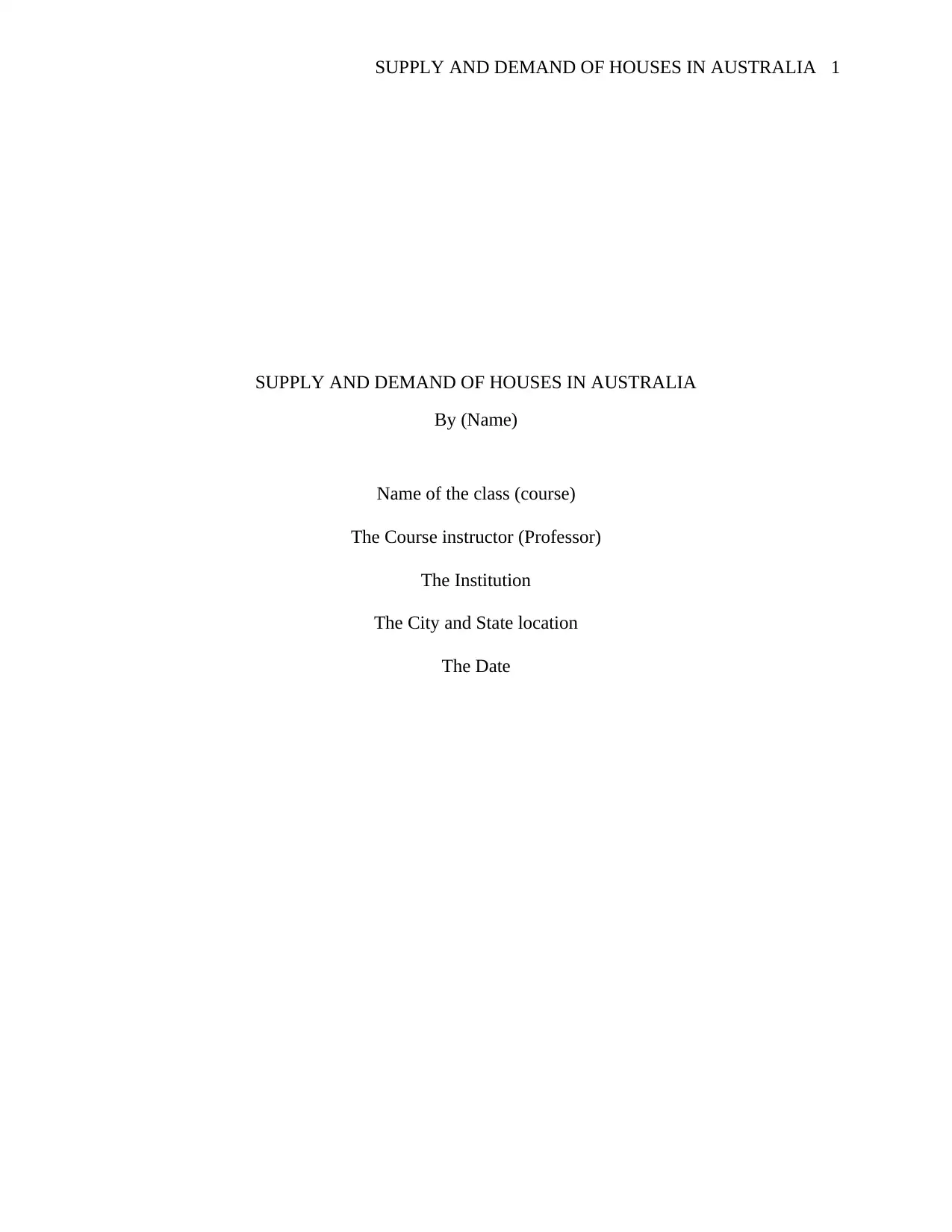
SUPPLY AND DEMAND OF HOUSES IN AUSTRALIA 1
SUPPLY AND DEMAND OF HOUSES IN AUSTRALIA
By (Name)
Name of the class (course)
The Course instructor (Professor)
The Institution
The City and State location
The Date
SUPPLY AND DEMAND OF HOUSES IN AUSTRALIA
By (Name)
Name of the class (course)
The Course instructor (Professor)
The Institution
The City and State location
The Date
Secure Best Marks with AI Grader
Need help grading? Try our AI Grader for instant feedback on your assignments.
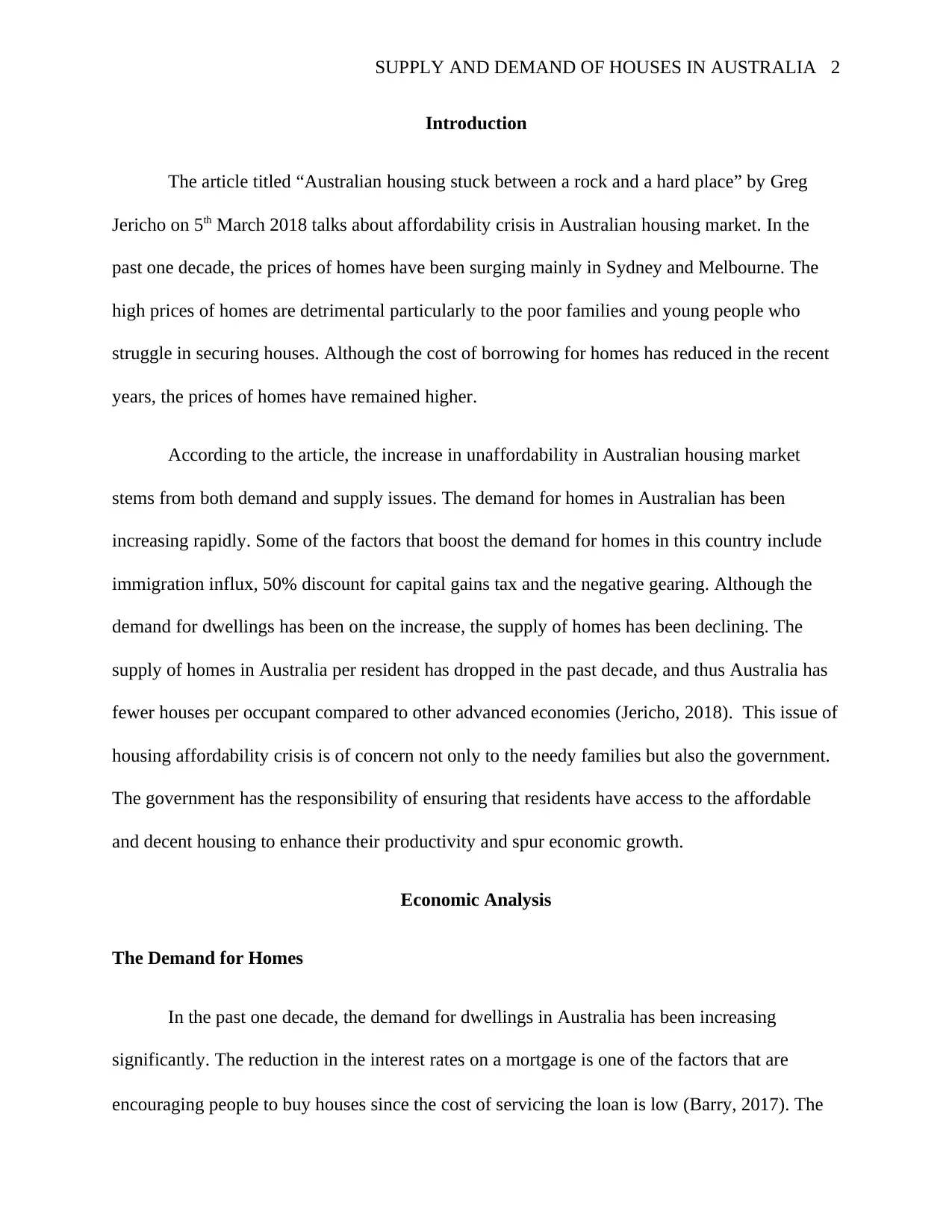
SUPPLY AND DEMAND OF HOUSES IN AUSTRALIA 2
Introduction
The article titled “Australian housing stuck between a rock and a hard place” by Greg
Jericho on 5th March 2018 talks about affordability crisis in Australian housing market. In the
past one decade, the prices of homes have been surging mainly in Sydney and Melbourne. The
high prices of homes are detrimental particularly to the poor families and young people who
struggle in securing houses. Although the cost of borrowing for homes has reduced in the recent
years, the prices of homes have remained higher.
According to the article, the increase in unaffordability in Australian housing market
stems from both demand and supply issues. The demand for homes in Australian has been
increasing rapidly. Some of the factors that boost the demand for homes in this country include
immigration influx, 50% discount for capital gains tax and the negative gearing. Although the
demand for dwellings has been on the increase, the supply of homes has been declining. The
supply of homes in Australia per resident has dropped in the past decade, and thus Australia has
fewer houses per occupant compared to other advanced economies (Jericho, 2018). This issue of
housing affordability crisis is of concern not only to the needy families but also the government.
The government has the responsibility of ensuring that residents have access to the affordable
and decent housing to enhance their productivity and spur economic growth.
Economic Analysis
The Demand for Homes
In the past one decade, the demand for dwellings in Australia has been increasing
significantly. The reduction in the interest rates on a mortgage is one of the factors that are
encouraging people to buy houses since the cost of servicing the loan is low (Barry, 2017). The
Introduction
The article titled “Australian housing stuck between a rock and a hard place” by Greg
Jericho on 5th March 2018 talks about affordability crisis in Australian housing market. In the
past one decade, the prices of homes have been surging mainly in Sydney and Melbourne. The
high prices of homes are detrimental particularly to the poor families and young people who
struggle in securing houses. Although the cost of borrowing for homes has reduced in the recent
years, the prices of homes have remained higher.
According to the article, the increase in unaffordability in Australian housing market
stems from both demand and supply issues. The demand for homes in Australian has been
increasing rapidly. Some of the factors that boost the demand for homes in this country include
immigration influx, 50% discount for capital gains tax and the negative gearing. Although the
demand for dwellings has been on the increase, the supply of homes has been declining. The
supply of homes in Australia per resident has dropped in the past decade, and thus Australia has
fewer houses per occupant compared to other advanced economies (Jericho, 2018). This issue of
housing affordability crisis is of concern not only to the needy families but also the government.
The government has the responsibility of ensuring that residents have access to the affordable
and decent housing to enhance their productivity and spur economic growth.
Economic Analysis
The Demand for Homes
In the past one decade, the demand for dwellings in Australia has been increasing
significantly. The reduction in the interest rates on a mortgage is one of the factors that are
encouraging people to buy houses since the cost of servicing the loan is low (Barry, 2017). The
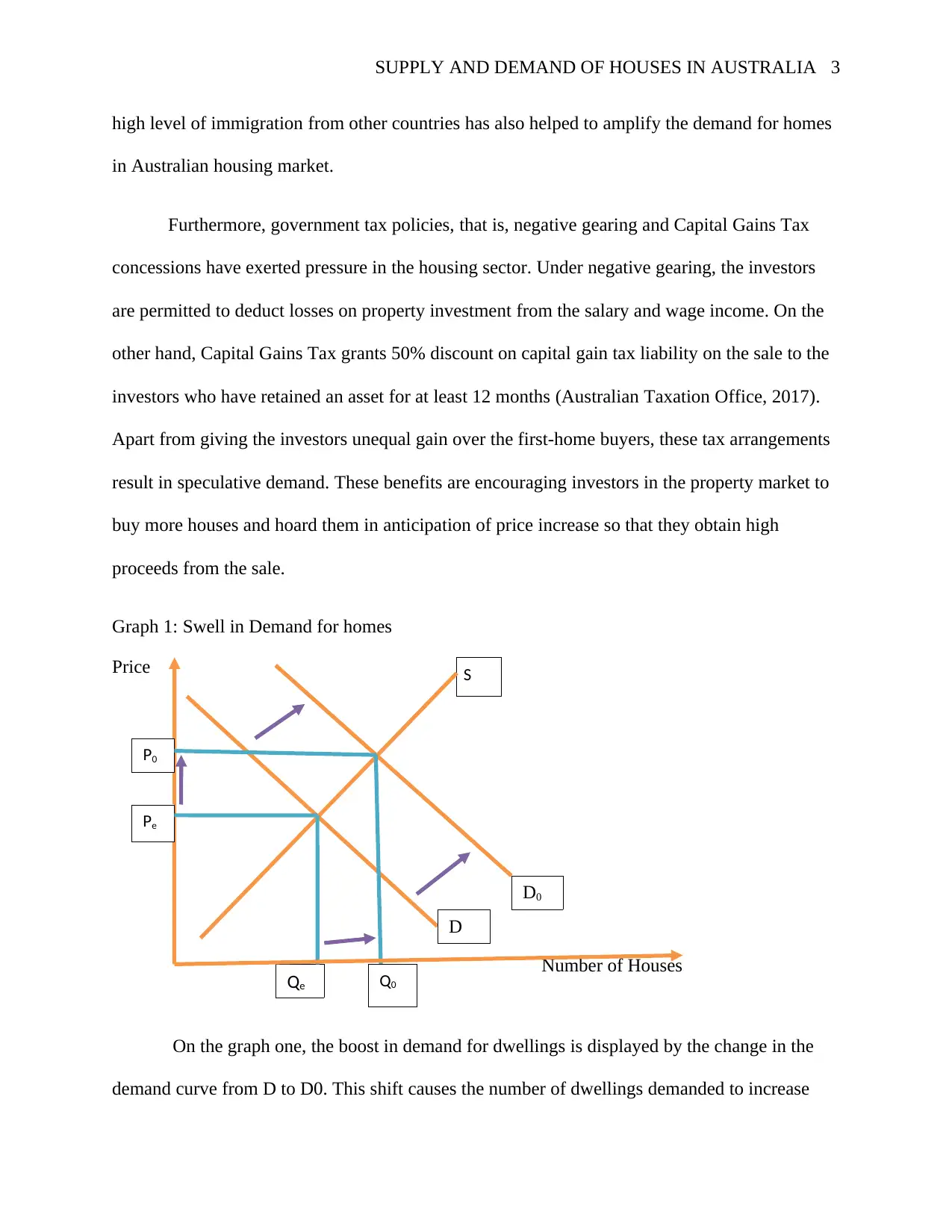
SUPPLY AND DEMAND OF HOUSES IN AUSTRALIA 3
high level of immigration from other countries has also helped to amplify the demand for homes
in Australian housing market.
Furthermore, government tax policies, that is, negative gearing and Capital Gains Tax
concessions have exerted pressure in the housing sector. Under negative gearing, the investors
are permitted to deduct losses on property investment from the salary and wage income. On the
other hand, Capital Gains Tax grants 50% discount on capital gain tax liability on the sale to the
investors who have retained an asset for at least 12 months (Australian Taxation Office, 2017).
Apart from giving the investors unequal gain over the first-home buyers, these tax arrangements
result in speculative demand. These benefits are encouraging investors in the property market to
buy more houses and hoard them in anticipation of price increase so that they obtain high
proceeds from the sale.
Graph 1: Swell in Demand for homes
Price
Number of Houses
On the graph one, the boost in demand for dwellings is displayed by the change in the
demand curve from D to D0. This shift causes the number of dwellings demanded to increase
S
P0
Pe
Q0Qe
D0
D
high level of immigration from other countries has also helped to amplify the demand for homes
in Australian housing market.
Furthermore, government tax policies, that is, negative gearing and Capital Gains Tax
concessions have exerted pressure in the housing sector. Under negative gearing, the investors
are permitted to deduct losses on property investment from the salary and wage income. On the
other hand, Capital Gains Tax grants 50% discount on capital gain tax liability on the sale to the
investors who have retained an asset for at least 12 months (Australian Taxation Office, 2017).
Apart from giving the investors unequal gain over the first-home buyers, these tax arrangements
result in speculative demand. These benefits are encouraging investors in the property market to
buy more houses and hoard them in anticipation of price increase so that they obtain high
proceeds from the sale.
Graph 1: Swell in Demand for homes
Price
Number of Houses
On the graph one, the boost in demand for dwellings is displayed by the change in the
demand curve from D to D0. This shift causes the number of dwellings demanded to increase
S
P0
Pe
Q0Qe
D0
D
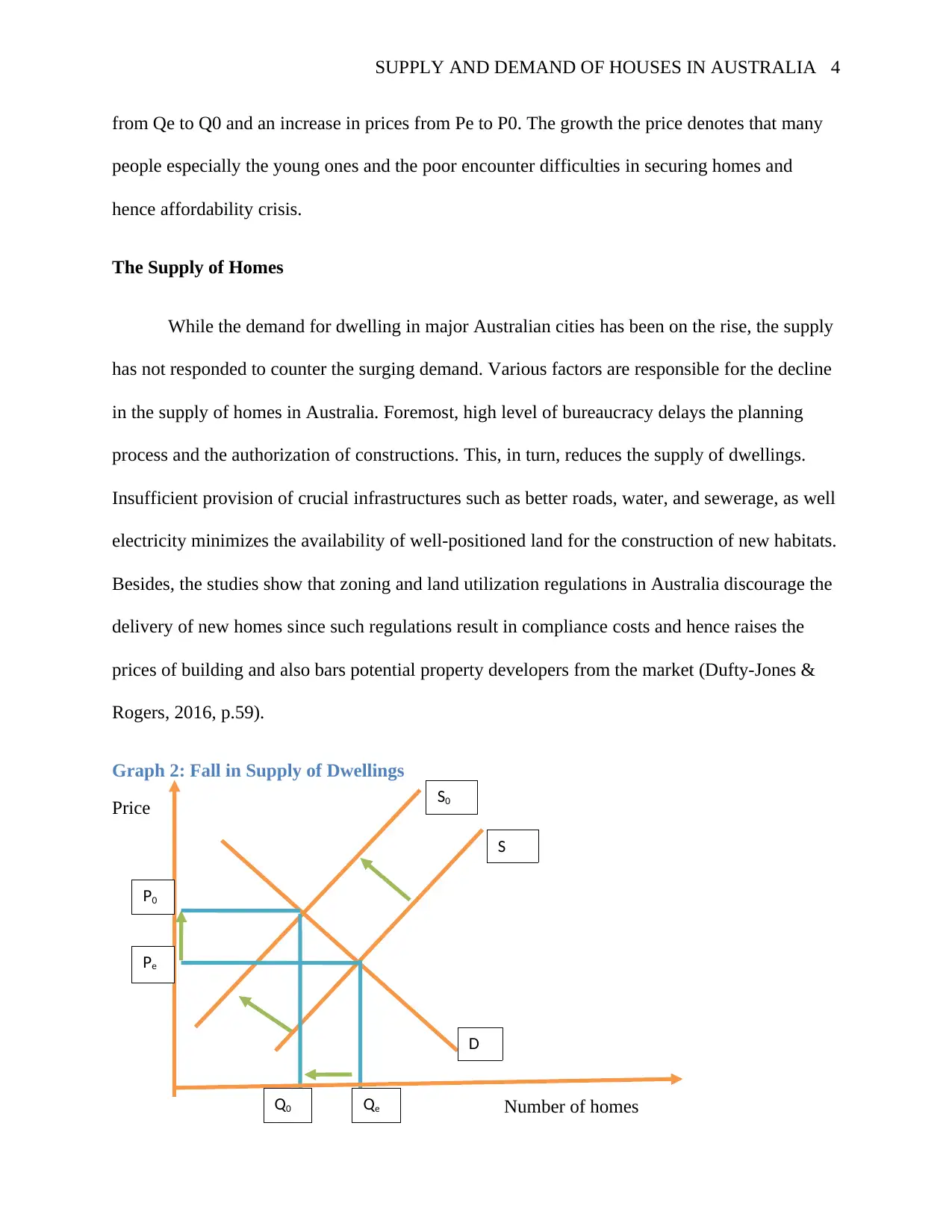
SUPPLY AND DEMAND OF HOUSES IN AUSTRALIA 4
from Qe to Q0 and an increase in prices from Pe to P0. The growth the price denotes that many
people especially the young ones and the poor encounter difficulties in securing homes and
hence affordability crisis.
The Supply of Homes
While the demand for dwelling in major Australian cities has been on the rise, the supply
has not responded to counter the surging demand. Various factors are responsible for the decline
in the supply of homes in Australia. Foremost, high level of bureaucracy delays the planning
process and the authorization of constructions. This, in turn, reduces the supply of dwellings.
Insufficient provision of crucial infrastructures such as better roads, water, and sewerage, as well
electricity minimizes the availability of well-positioned land for the construction of new habitats.
Besides, the studies show that zoning and land utilization regulations in Australia discourage the
delivery of new homes since such regulations result in compliance costs and hence raises the
prices of building and also bars potential property developers from the market (Dufty-Jones &
Rogers, 2016, p.59).
Graph 2: Fall in Supply of Dwellings
Price
Number of homes
P0
Pe
S
D
QeQ0
S0
from Qe to Q0 and an increase in prices from Pe to P0. The growth the price denotes that many
people especially the young ones and the poor encounter difficulties in securing homes and
hence affordability crisis.
The Supply of Homes
While the demand for dwelling in major Australian cities has been on the rise, the supply
has not responded to counter the surging demand. Various factors are responsible for the decline
in the supply of homes in Australia. Foremost, high level of bureaucracy delays the planning
process and the authorization of constructions. This, in turn, reduces the supply of dwellings.
Insufficient provision of crucial infrastructures such as better roads, water, and sewerage, as well
electricity minimizes the availability of well-positioned land for the construction of new habitats.
Besides, the studies show that zoning and land utilization regulations in Australia discourage the
delivery of new homes since such regulations result in compliance costs and hence raises the
prices of building and also bars potential property developers from the market (Dufty-Jones &
Rogers, 2016, p.59).
Graph 2: Fall in Supply of Dwellings
Price
Number of homes
P0
Pe
S
D
QeQ0
S0
Secure Best Marks with AI Grader
Need help grading? Try our AI Grader for instant feedback on your assignments.
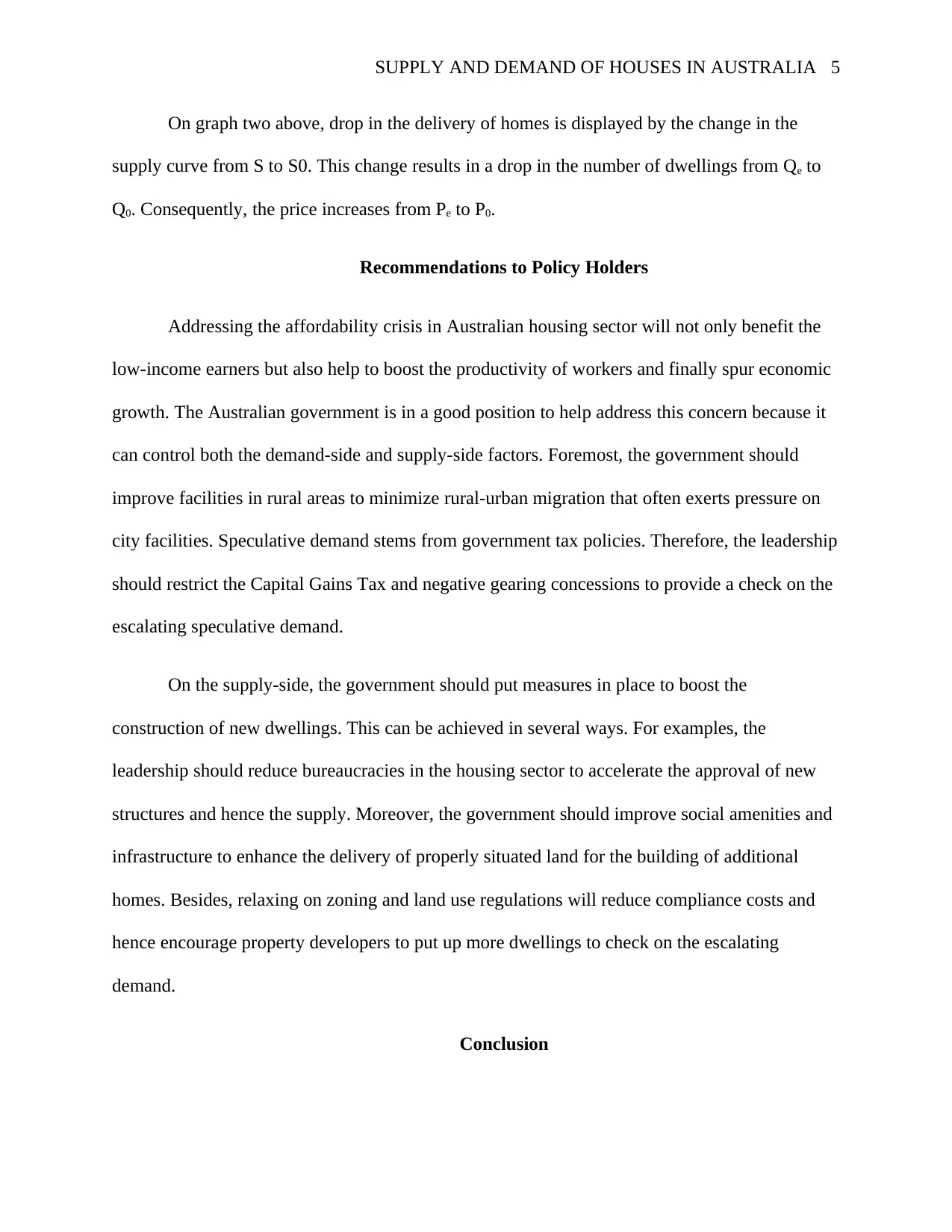
SUPPLY AND DEMAND OF HOUSES IN AUSTRALIA 5
On graph two above, drop in the delivery of homes is displayed by the change in the
supply curve from S to S0. This change results in a drop in the number of dwellings from Qe to
Q0. Consequently, the price increases from Pe to P0.
Recommendations to Policy Holders
Addressing the affordability crisis in Australian housing sector will not only benefit the
low-income earners but also help to boost the productivity of workers and finally spur economic
growth. The Australian government is in a good position to help address this concern because it
can control both the demand-side and supply-side factors. Foremost, the government should
improve facilities in rural areas to minimize rural-urban migration that often exerts pressure on
city facilities. Speculative demand stems from government tax policies. Therefore, the leadership
should restrict the Capital Gains Tax and negative gearing concessions to provide a check on the
escalating speculative demand.
On the supply-side, the government should put measures in place to boost the
construction of new dwellings. This can be achieved in several ways. For examples, the
leadership should reduce bureaucracies in the housing sector to accelerate the approval of new
structures and hence the supply. Moreover, the government should improve social amenities and
infrastructure to enhance the delivery of properly situated land for the building of additional
homes. Besides, relaxing on zoning and land use regulations will reduce compliance costs and
hence encourage property developers to put up more dwellings to check on the escalating
demand.
Conclusion
On graph two above, drop in the delivery of homes is displayed by the change in the
supply curve from S to S0. This change results in a drop in the number of dwellings from Qe to
Q0. Consequently, the price increases from Pe to P0.
Recommendations to Policy Holders
Addressing the affordability crisis in Australian housing sector will not only benefit the
low-income earners but also help to boost the productivity of workers and finally spur economic
growth. The Australian government is in a good position to help address this concern because it
can control both the demand-side and supply-side factors. Foremost, the government should
improve facilities in rural areas to minimize rural-urban migration that often exerts pressure on
city facilities. Speculative demand stems from government tax policies. Therefore, the leadership
should restrict the Capital Gains Tax and negative gearing concessions to provide a check on the
escalating speculative demand.
On the supply-side, the government should put measures in place to boost the
construction of new dwellings. This can be achieved in several ways. For examples, the
leadership should reduce bureaucracies in the housing sector to accelerate the approval of new
structures and hence the supply. Moreover, the government should improve social amenities and
infrastructure to enhance the delivery of properly situated land for the building of additional
homes. Besides, relaxing on zoning and land use regulations will reduce compliance costs and
hence encourage property developers to put up more dwellings to check on the escalating
demand.
Conclusion
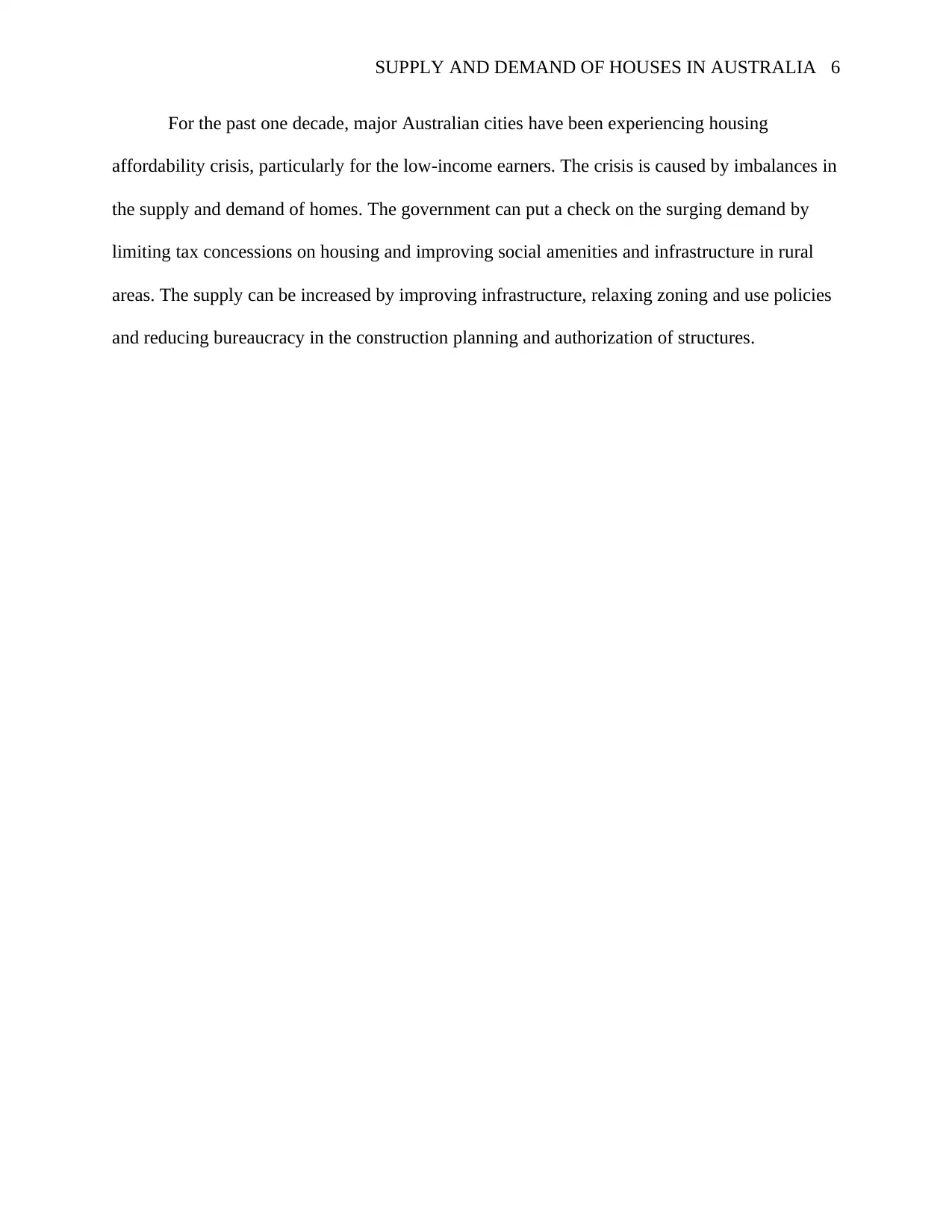
SUPPLY AND DEMAND OF HOUSES IN AUSTRALIA 6
For the past one decade, major Australian cities have been experiencing housing
affordability crisis, particularly for the low-income earners. The crisis is caused by imbalances in
the supply and demand of homes. The government can put a check on the surging demand by
limiting tax concessions on housing and improving social amenities and infrastructure in rural
areas. The supply can be increased by improving infrastructure, relaxing zoning and use policies
and reducing bureaucracy in the construction planning and authorization of structures.
For the past one decade, major Australian cities have been experiencing housing
affordability crisis, particularly for the low-income earners. The crisis is caused by imbalances in
the supply and demand of homes. The government can put a check on the surging demand by
limiting tax concessions on housing and improving social amenities and infrastructure in rural
areas. The supply can be increased by improving infrastructure, relaxing zoning and use policies
and reducing bureaucracy in the construction planning and authorization of structures.
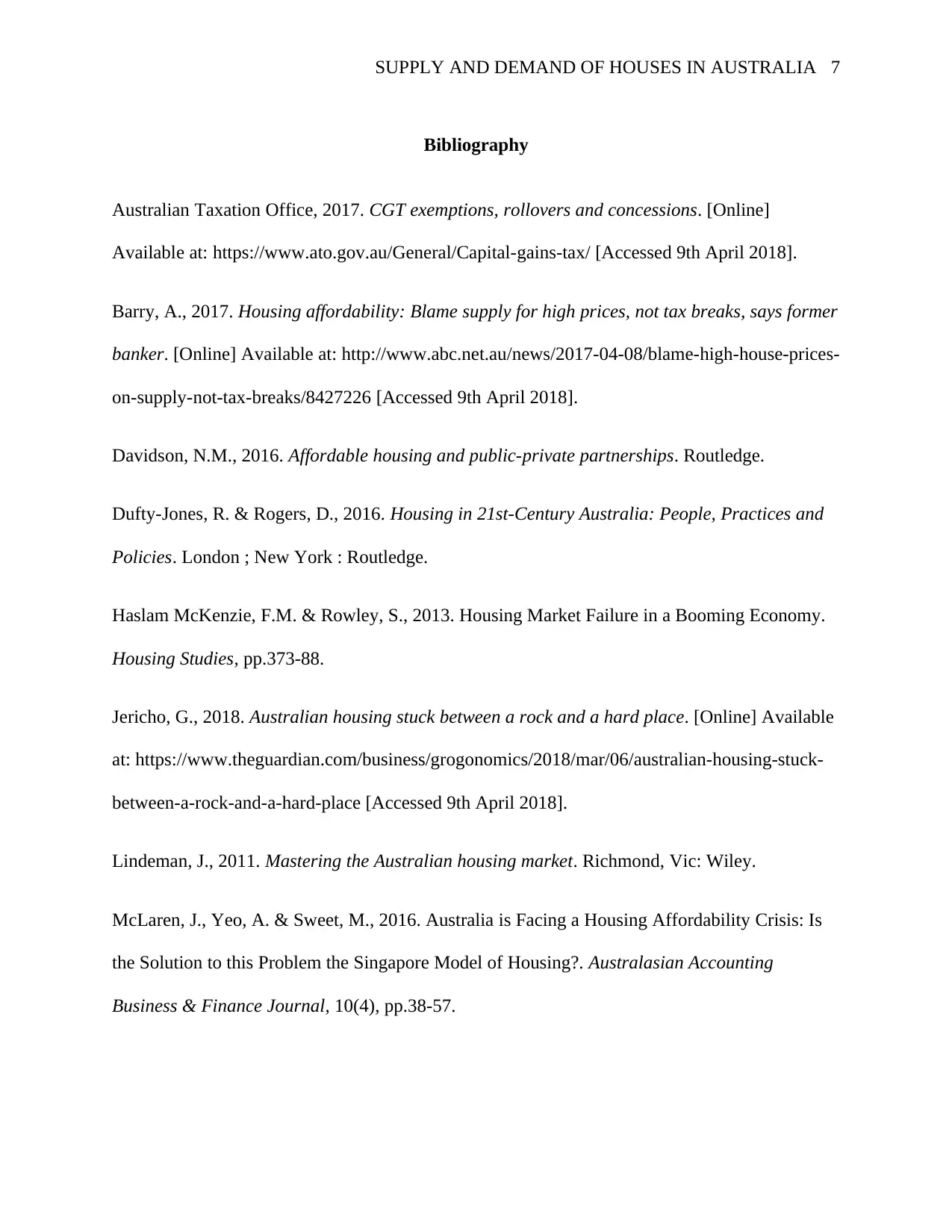
SUPPLY AND DEMAND OF HOUSES IN AUSTRALIA 7
Bibliography
Australian Taxation Office, 2017. CGT exemptions, rollovers and concessions. [Online]
Available at: https://www.ato.gov.au/General/Capital-gains-tax/ [Accessed 9th April 2018].
Barry, A., 2017. Housing affordability: Blame supply for high prices, not tax breaks, says former
banker. [Online] Available at: http://www.abc.net.au/news/2017-04-08/blame-high-house-prices-
on-supply-not-tax-breaks/8427226 [Accessed 9th April 2018].
Davidson, N.M., 2016. Affordable housing and public-private partnerships. Routledge.
Dufty-Jones, R. & Rogers, D., 2016. Housing in 21st-Century Australia: People, Practices and
Policies. London ; New York : Routledge.
Haslam McKenzie, F.M. & Rowley, S., 2013. Housing Market Failure in a Booming Economy.
Housing Studies, pp.373-88.
Jericho, G., 2018. Australian housing stuck between a rock and a hard place. [Online] Available
at: https://www.theguardian.com/business/grogonomics/2018/mar/06/australian-housing-stuck-
between-a-rock-and-a-hard-place [Accessed 9th April 2018].
Lindeman, J., 2011. Mastering the Australian housing market. Richmond, Vic: Wiley.
McLaren, J., Yeo, A. & Sweet, M., 2016. Australia is Facing a Housing Affordability Crisis: Is
the Solution to this Problem the Singapore Model of Housing?. Australasian Accounting
Business & Finance Journal, 10(4), pp.38-57.
Bibliography
Australian Taxation Office, 2017. CGT exemptions, rollovers and concessions. [Online]
Available at: https://www.ato.gov.au/General/Capital-gains-tax/ [Accessed 9th April 2018].
Barry, A., 2017. Housing affordability: Blame supply for high prices, not tax breaks, says former
banker. [Online] Available at: http://www.abc.net.au/news/2017-04-08/blame-high-house-prices-
on-supply-not-tax-breaks/8427226 [Accessed 9th April 2018].
Davidson, N.M., 2016. Affordable housing and public-private partnerships. Routledge.
Dufty-Jones, R. & Rogers, D., 2016. Housing in 21st-Century Australia: People, Practices and
Policies. London ; New York : Routledge.
Haslam McKenzie, F.M. & Rowley, S., 2013. Housing Market Failure in a Booming Economy.
Housing Studies, pp.373-88.
Jericho, G., 2018. Australian housing stuck between a rock and a hard place. [Online] Available
at: https://www.theguardian.com/business/grogonomics/2018/mar/06/australian-housing-stuck-
between-a-rock-and-a-hard-place [Accessed 9th April 2018].
Lindeman, J., 2011. Mastering the Australian housing market. Richmond, Vic: Wiley.
McLaren, J., Yeo, A. & Sweet, M., 2016. Australia is Facing a Housing Affordability Crisis: Is
the Solution to this Problem the Singapore Model of Housing?. Australasian Accounting
Business & Finance Journal, 10(4), pp.38-57.
Paraphrase This Document
Need a fresh take? Get an instant paraphrase of this document with our AI Paraphraser

SUPPLY AND DEMAND OF HOUSES IN AUSTRALIA 8
1 out of 8
Related Documents
Your All-in-One AI-Powered Toolkit for Academic Success.
+13062052269
info@desklib.com
Available 24*7 on WhatsApp / Email
![[object Object]](/_next/static/media/star-bottom.7253800d.svg)
Unlock your academic potential
© 2024 | Zucol Services PVT LTD | All rights reserved.





